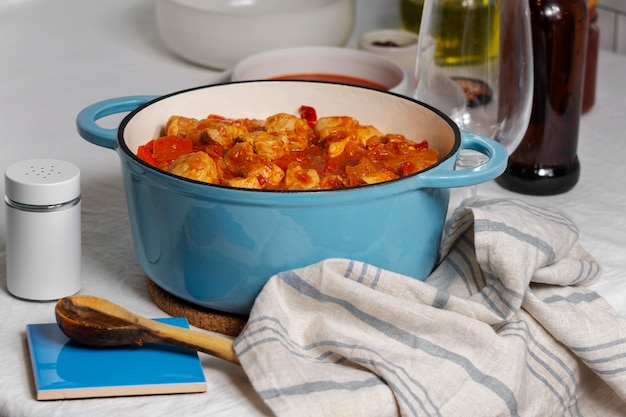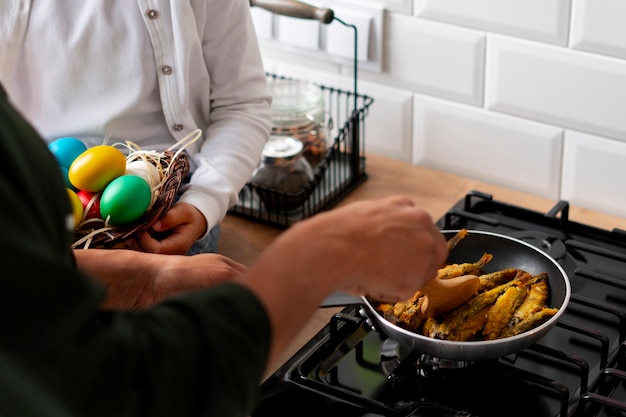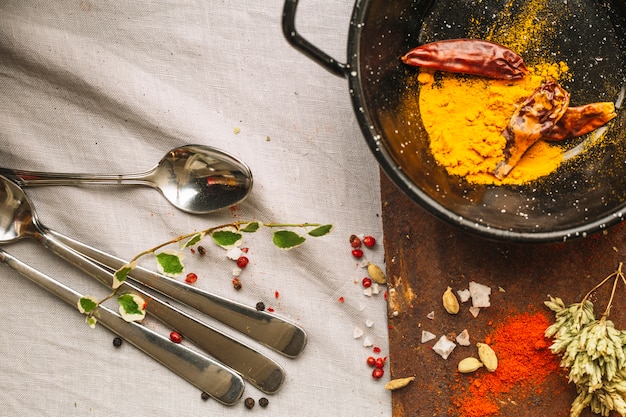(Part 1) The Foundation of a Perfect Stew

1. The Right Ingredients: A Recipe for Success
The first step to crafting a delicious stew is choosing the right ingredients. Think of it as building a foundation. Just like you wouldn't build a house on shaky ground, you can't expect a stew to be a winner if you're not starting with quality ingredients.Let's talk meat first. For a hearty beef stew, I always opt for a good cut of chuck or brisket. These cuts are tougher, yes, but that's what makes them ideal for slow cooking. Their flavour intensifies and they become wonderfully tender with a long simmer. And don't shy away from a little fat! That's what adds richness and depth to the stew.
Then, there are the vegetables. A good stew needs a mix of textures and flavours. Root vegetables like carrots, potatoes, and parsnips are classics for a reason. They hold up well in the long cooking process and add a sweetness that balances the richness of the meat.
Don't forget the aromatic ingredients! These are the secret weapon that elevates a stew from good to phenomenal. Think onions, garlic, celery - they form the base flavour that everything else builds upon. And don't skimp on herbs and spices! A bay leaf, a sprig of thyme, some black peppercorns - these subtle additions create a symphony of aromas and flavours that make your stew truly unforgettable.
2. The Power of Aromatics: A Symphony of Flavors
Aromas are the heart and soul of a good stew. They add layers of complexity and depth, making it truly unforgettable.Think about it: onions, garlic, celery, these are the foundation of any good stew. Don't be shy with them; use plenty! They provide a base flavour that everything else builds on. And don't forget about herbs and spices. A bay leaf, a sprig of thyme, some black peppercorns – these little touches add a depth of flavour that will make your stew truly sing.
3. The Magic of Liquid: A Broth for the Soul
Now, let's talk about the liquid. You can't just dump ingredients in a pot and expect them to cook themselves, can you? You need a good broth, one that's packed with flavour and has a good body to it.I always prefer to make my own broth from scratch using chicken or beef bones. It takes a bit longer, but the flavour is so much more intense and rich. The process of simmering bones with vegetables, herbs, and spices creates a broth that's truly magical. If you're short on time, a good quality store-bought broth will do the trick, but always check the ingredients list to avoid any unnecessary additives.
(Part 2) The Art of Slow Cooking: A Gentle Embrace

1. The Science Behind Long, Slow Cooking
Why do we cook stews slowly? It's not just tradition, it's science!When you cook meat at a low temperature over a long period, the collagen in the meat breaks down into gelatin. This process creates a tender, melt-in-your-mouth texture that is simply divine. The same goes for vegetables; they become more tender and release their flavours into the broth, creating a harmonious symphony of tastes.
2. The Right Heat for a Perfect Stew
Now, let's talk about temperature. Too high, and you risk burning your stew. Too low, and it'll take forever to cook.I always recommend a low simmer, just below a gentle bubble. You should see tiny bubbles forming around the edges of the pot, indicating that the heat is penetrating the food evenly. This slow, gentle heat allows the tough proteins to break down and the flavours to meld beautifully.
3. Timing is Everything: The Golden Rule of Stew Cooking
Here's the thing about stew cooking times: there isn't a one-size-fits-all answer. It depends on the ingredients, the size of the chunks, and your desired level of tenderness. But there are some general guidelines to follow.For example, a beef stew will usually need about 2-3 hours of simmering, sometimes even longer. Chicken stew, on the other hand, is usually ready in about 1.5 hours. The best way to know if your stew is done is to check the meat. It should be tender and easily pull apart with a fork.
(Part 3) Mastering the Art of Timing

1. The Importance of Checking for Doneness
Remember, those cooking times are just guidelines. The best way to know if your stew is done is to check it regularly.After an hour or so, start checking the meat. Use a fork to pierce it and see if it's easily giving way. If it's still tough, give it another 30 minutes or so. Don't be afraid to overcook your stew. The longer it cooks, the more tender it'll become.
2. The Art of Deglazing: A Flavor Boost
Once the meat is tender and the vegetables are soft, you might want to add an extra layer of flavour to your stew. That's where deglazing comes in.Deglazing is basically scraping up all the delicious bits stuck to the bottom of your pot. Simply add a splash of wine or broth to the pot and let it simmer for a few minutes. This process will loosen the caramelized bits and release a burst of flavour, transforming your stew into something truly exceptional.
3. Don't Forget About Resting: A Moment of Relaxation
Once your stew is cooked, don't rush to serve it just yet. Give it a chance to rest.Take the stew off the heat and let it sit for at least 15 minutes. This allows the flavours to meld and intensify, creating a smoother, more velvety stew. It's a small step, but it makes a big difference in the final flavour.
(Part 4) Stew Variations: A World of Possibilities
1. From Classic to Contemporary: Exploring Different Stews
Stews are incredibly versatile, adaptable to any taste and occasion. You can stick with the classics like beef stew or venture into the world of Moroccan lamb stew, Thai curry stew, or even a comforting vegetarian lentil stew.The possibilities are truly endless! Experiment with different meats, vegetables, herbs, and spices to create your own unique stew recipes.
2. The Power of Thickening: A Creamy Finish
A good stew should have a nice, rich sauce. Sometimes, the sauce can be a bit thin, especially after a long cooking time. Don't worry, you can easily thicken it up!There are a few ways to thicken your stew. You can add a tablespoon of cornstarch or flour to the broth, or you can use a little bit of butter and flour for a richer flavour. You could even use a little bit of cream or yoghurt to make it creamy. The choice is yours!
(Part 5) Serving Your Stew: A Feast for the Senses
1. The Perfect Accompaniments: A Symphony of Flavors
Your stew is cooked, ready to be served. But let's not forget about the accompaniments. They play a crucial role in creating a well-rounded meal.A crusty bread is a must-have for any stew. It's perfect for soaking up the delicious sauce and adding a satisfying texture contrast. A green salad adds a refreshing touch, balancing the richness of the stew. And a dollop of sour cream or yoghurt can bring a nice tangy flavour.
2. Presentation Matters: A Culinary Masterpiece
A well-presented dish is always more inviting, don't you think? It's the little details that make all the difference.When serving your stew, ladle it into individual bowls or a large serving dish. Garnish it with fresh herbs, a sprinkle of grated cheese, or a few slices of lemon. The visual appeal will enhance the dining experience.
(Part 6) Stew Cooking Times: A Cheat Sheet
Here's a quick guide to typical stew cooking times:| Ingredient | Cooking Time |
|---|---|
| Beef Stew Meat | 2-3 hours |
| Chicken Stew Meat | 1-1.5 hours |
| Lamb Stew Meat | 1.5-2 hours |
| Root Vegetables (Carrots, Potatoes, Parsnips) | 45 minutes - 1 hour |
| Other Vegetables (Celery, Onions, Mushrooms) | 30 minutes - 45 minutes |
(Part 7) Tips and Tricks: Secrets of the Kitchen
Here are a few more tips and tricks to help you cook the perfect stew:- Use a dutch oven. They're designed for long, slow cooking and retain heat well, ensuring an even cooking process.
- Don't overcrowd the pot. Give the ingredients room to cook evenly and prevent them from steaming instead of browning.
- Season liberally. Salt and pepper are essential for bringing out the flavours of your stew. Remember, you can always add more salt later, but it's difficult to remove excess salt.
- Don't be afraid to experiment. Try different combinations of ingredients and spices to find your own favourite stew recipe. The world of stews is your oyster!
(Part 8) FAQs: Your Stew Queries Answered
1. What if my stew is too salty?
Don't panic! You can add a little bit of sugar to balance out the saltiness. Or, you can add a little more liquid to dilute the flavour. A pinch of lemon juice can also help cut through the saltiness.2. Can I freeze stew?
Yes, you can definitely freeze stew. It's best to freeze it in portions, so you can easily thaw and reheat individual servings. When reheating frozen stew, do it slowly on the stovetop to avoid burning.3. How long does it take to cook a stew in a slow cooker?
Stews cook beautifully in slow cookers. For beef stew, you'll need about 6-8 hours on low or 3-4 hours on high. For chicken stew, 4-6 hours on low or 2-3 hours on high is usually enough.4. What kind of wine should I use for deglazing?
You can use any kind of wine for deglazing, but a dry red wine is typically the best choice. It adds a nice depth of flavour to the stew. If you're avoiding alcohol, a splash of broth or even water can work just as well.5. How do I know when my stew is done?
The meat should be tender and easily pull apart with a fork. The vegetables should be soft and cooked through. The sauce should be thick and flavorful. If you're unsure, give it a taste test!(Part 9) Conclusion: A Journey into Stew Perfection
And that's it! You now have all the tools and knowledge you need to cook a perfect stew. Don't be afraid to experiment and have fun with it.Remember, cooking is about creating something delicious and enjoyable. So, get in the kitchen, gather your ingredients, and start simmering!
Everyone is watching

Corn on the Cob: The Ultimate Guide to Perfectly Cooked Ears
Healthy MealsAh, corn on the cob. Just the name evokes images of sunny days, barbecues, and that sweet, juicy flavour that ...

Perfect Pork Roast Oven Cooking Time: A Guide to Delicious Results
Healthy MealsThere's something truly satisfying about a perfectly roasted pork. The aroma alone is enough to make your mout...

Ham Cooking Time: How Long to Bake, Smoke, or Boil a Delicious Ham
Healthy MealsAh, ham. It's a classic, isn't it? A real crowd-pleaser, especially around holidays. And when done right, it'...

Scallops: The Ultimate Guide to Perfect Cooking
Healthy MealsAh, scallops. Those delicate, sweet, and utterly delicious morsels of the sea. They hold a special place in my...

Spaghetti Squash: The Ultimate Guide to Cooking and Serving
Healthy MealsRemember that time you saw spaghetti squash at the supermarket, looking all bumpy and strange, and thought, "W...
